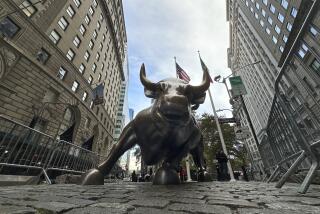Retail data feed anxiety on Wall St.
- Share via
LOS ANGELES AND NEW YORK — The stock market endured its second thrashing in two days Thursday as dismal retail sales raised concern that a global recession could be longer and deeper than thought likely even a few weeks ago.
Weak October sales and downbeat earnings projections at companies such as Nordstrom Inc. and J.C. Penney Co. indicated that consumers were cutting spending in favor of paying off debt and preserving cash amid job-market insecurity.
The Dow Jones industrial average sagged almost 450 points in a near-replay of Wednesday’s 486-point drop -- a total two-day drop of 9.7% -- and investors braced for potentially more losses today when the government releases its closely watched monthly unemployment report.
The economic turmoil also was reflected in the commodities markets, where crude oil and other prices fell sharply for the second consecutive day on fears of slowing worldwide demand.
“Over the last couple of days, now that the election is behind us, it appears that the equity market is seeing even more negative earnings and economic issues on the horizon, and an even more severe and prolonged downturn than previously anticipated,” said Richard Weiss, chief investment officer at City National Bank in Beverly Hills.
The stock market sell-off illustrated the extent to which fear is gripping the markets.
Retail sales were widely expected to be weak in October, when the worst fallout from the housing collapse and credit crisis dominated the markets and presidential election. Yet share prices were pounded anyway.
“We’ve got markets trading on raw and pure emotion,” said Jim Paulsen, chief investment strategist of Wells Capital Management. “It has little to do with fundamentals.”
The Dow plummeted 443.48 points, or 4.9%, to 8,695.79. Combined with Wednesday’s drop, the Dow suffered its biggest two-day percentage decline since the October 1987 market collapse.
The Standard & Poor’s 500 index slid 47.88 points, or 5%, to 904.88. The Nasdaq composite index dropped 72.94 points, or 4.3%, to 1,608.70
Despite the sell-off, many investment pros cling to the hope that the major averages will remain above last month’s lows. The Dow is 520 points above its Oct. 27 trough of 8,175.77, while the S&P; is 56 points above its bottom of 848.92.
Economic worries pushed oil lower for a second day, and heating oil and copper fell more than 5% while natural gas was off more than 4.3%.
The U.S. benchmark light sweet crude traded as low as $60.16 before closing at $60.77 a barrel, down $4.53, or 7%. That’s the lowest since March 2007 and marks a 59% drop from the record trading high of $147.27 in July.
Analysts said that oil trading on the New York commodities market was first hammered when the Bank of England cut interest rates by a larger-than-expected 1.5 percentage points to 3%. The European Central Bank lopped its rate by half a point, and its president hinted that further cuts would be coming.
The Bank of England’s move sent the value of the dollar soaring, which makes dollar-denominated oil more expensive for foreign buyers. The euro, which cost more than $1.60 in April, is now down to $1.27.
“The U.S. dollar is rebounding quite hard from the big rate cut from the British central bank, and there are a lot of other external things pushing oil around today,” said Sean Brodrick, a natural resource analyst for the online newsletter Money and Markets.
But weighing even heavier was concern that the economic slump would cause already sluggish demand for oil and fuels to fall more.
The Chinese economy, which had been a juggernaut driving up the price of oil from early 2005 to the Summer Olympics, is slowing, he said.
“China was one of the last legs of hope for the oil traders,” said Brodrick, who sees oil dropping as low as $50 a barrel in the coming days. That milestone would make oil the cheapest it’s been in 3 1/2 years.
Other analysts also said that the big cut in Saudi Arabia’s oil production was misinterpreted early this week as a bullish sign that the Organization of the Petroleum Exporting Countries would stand firm on reining in oil supplies to stabilize the price of oil, contributing to a one-day bump above $70.
Fadel Gheit, senior energy analyst at Oppenheimer & Co., said that the Saudis had little choice.
“Refineries around the world are reducing their runs because there is no demand for their refined products,” Gheit said. “If the demand for refined product is weak, the demand for oil is weak. The Saudis are cutting production because no one needs their oil as much as before.”
Oil’s fall has helped retail gasoline prices to continue their slide. The U.S. average price for a gallon of self-serve regular was $2.34 on Thursday, down 2.5 cents from Wednesday and off $1.14 from a month earlier, according to AAA’s daily price survey.
On Wall Street, stocks are being hurt by steady bad news as companies rein in earnings estimates almost daily.
Technology stocks got hit after networking giant Cisco Systems Inc., which is considered a bellwether for overall industry demand, forecast late Wednesday that sales would decline as much as 10% in its fiscal second quarter. Its shares fell 45 cents, or 2.6%, to $16.94.
The specter of continuing layoffs is haunting the market.
Initial claims for unemployment benefits ticked slightly lower last week -- dropping 4,000 to 481,000, according to the Labor Department -- but remained well above the 400,000 mark that historically accompanies recessions. Long-term claims reached their highest mark in 25 years.
Among retailers, Macy’s Inc. fell 41 cents, or 3.8%, to $10.44; Target Corp. sank $2.28, or 6%, to $35.47 and Gap Inc. slid 38 cents, or 3%, to $12.46.
Shares of Wal-Mart Stores Inc. dropped 64 cents, or 1%, to $53.49 even though its sales rose 2.4% as the consumer tilt toward the low-cost retailer highlighted the plight of higher-end competitors.
Among energy stocks, Exxon Mobil Corp. fell $3.73, or 5.1%, to $69.96, while Chevron Corp. was down $4.77, or 6.4%, to $70.11.
--
--
Data darken
economic picture
Retailers report miserable sales in October. PAGE A1
--
Obama’s Treasury choice is unclear
Advisors are split on Lawrence Summers. PAGE A14
More to Read
Inside the business of entertainment
The Wide Shot brings you news, analysis and insights on everything from streaming wars to production — and what it all means for the future.
You may occasionally receive promotional content from the Los Angeles Times.











